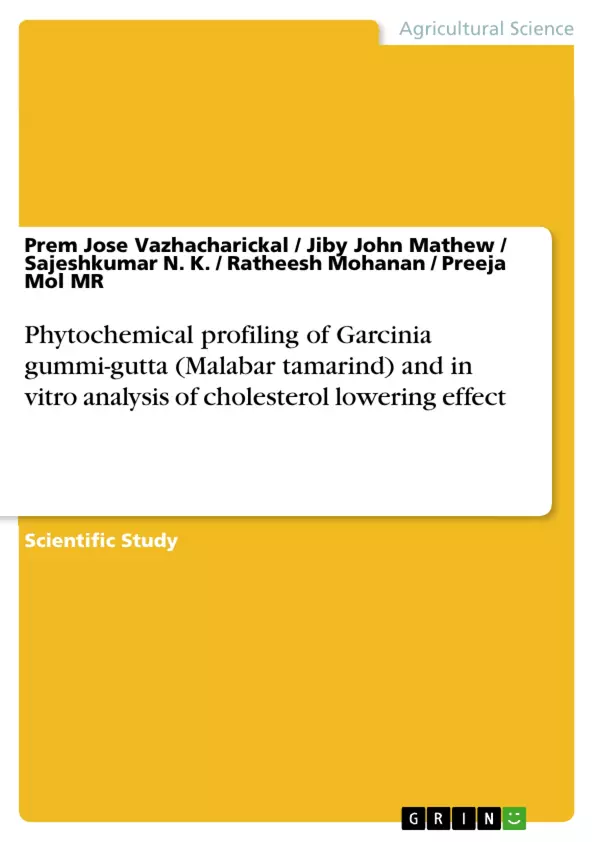In our society cholesterol related diseases are increasing day by day. The major reason for this is our eating habit or food habit. Eating foods containing trans fats, which are often found in fast food and commercially baked breads, cookies, and snack foods. It was observed that while peoples taking the fruits of Garcinia gummi-gutta in their food preparations have low cholesterol level. Some peoples are eating boiled fruits and drinking water in which the fruits peels are boiled in order to reduce the cholesterol level. This study was carried out to explore the phytochemical constituents of the solvent extracts of Garcinia gummi-gutta fruit and in vitro analysis of its cholesterol lowering effect. The cholesterol lowering effect was carried out in vitro using common fatty food materials like ghee, fats of pork and chicken, hen egg and cod liver oil. Each food materials were treated with extract and incubated for a number of days and each day the cholesterol level was estimated by Zak’s method. From the data, pork and chicken fat, egg yolk and ghee shows significant reduction in the cholesterol level. From the present study it can be concluded that the constituents present in the extracts may be responsible for the cholesterol lowering activity.
Table of Contents
- Table of contents
- Table of figures
- Table of tables
- List of abbreviations
- Phytochemical profiling of Garcinia gummi-gutta (Malabar tamarind) and in vitro analysis of cholesterol lowering effect
- Abstract
- Introduction
- Objectives
- Review of literature
- Hypothesis
- Materials and Methods
- Study area
- Collection of plant material
- Preparation of Garcinia gummi-gutta fruit pulp extracts
- Phytochemical screening
- Test for alkaloids
- Test for anthraquinones
- Test for anthocyanins
- Test for carbohydrate
- Test for coumarins
- Test for emodins
- Test for flavonoids
- Test for glycosides
- Test for leucoanthocyanins
- Test for phlobatannins
- Test for proteins
- Test for phenols
- Test for saponins
- Test for steroids
- Test for terpenoids
- Preparation of cholesterol samples
- Treatment
- Estimation of cholesterol
- Statistical analysis
- Results and discussion
- Conclusions
- Acknowledgements
- References
Objectives and Key Themes
This study aims to investigate the phytochemical properties of extracts from the fruit of Garcinia gummi-gutta and assess its potential to lower cholesterol levels in various fatty food materials. The study focuses on the presence of bioactive compounds in both methanol and water extracts of the fruit.
- Phytochemical profiling of Garcinia gummi-gutta fruit extracts
- Cholesterol-lowering effect of Garcinia gummi-gutta extracts
- Identification of potential bioactive compounds
- The role of specific phytochemicals in cholesterol reduction
- Comparison of the effectiveness of different solvent extracts
Chapter Summaries
- Introduction: This chapter introduces the topic of medicinal plants and their importance in traditional healthcare systems. It highlights the prevalence of plant-based remedies in developing countries and the growing interest in phytochemicals for treating various diseases, including those related to cholesterol. The chapter also discusses the increasing consumption of fatty foods and the need for natural solutions to manage cholesterol levels.
- Review of literature: This chapter provides an extensive review of the scientific literature on medicinal plants, cholesterol metabolism, and the specific properties of Garcinia gummi-gutta. It highlights the traditional uses of the plant in various cultures and explores its potential as a source of natural compounds with therapeutic benefits. The chapter also delves into the chemical properties of cholesterol and its role in the body.
- Materials and Methods: This chapter details the materials and methods used in the study. It outlines the collection of plant material, preparation of extracts, phytochemical screening techniques, cholesterol estimation methods, and statistical analysis procedures.
- Results and Discussion: This chapter presents the results of the phytochemical analysis and in vitro cholesterol-lowering studies. It describes the presence of various phytoconstituents in the fruit extracts and analyzes the effectiveness of the extracts in reducing cholesterol levels in different fatty food materials.
Keywords
The research focuses on the phytochemical properties of Garcinia gummi-gutta fruit extracts and their potential to reduce cholesterol levels. Key themes include the identification and analysis of phytochemicals, the mechanism of cholesterol reduction, and the evaluation of the effectiveness of different solvent extracts. Relevant keywords include: cholesterol, Garcinia gummi-gutta, Malabar tamarind, phytochemicals, emodins, coumarins, in vitro analysis, hypercholesterolemia, Zak’s method.
- Arbeit zitieren
- Dr. Prem Jose Vazhacharickal (Autor:in), Jiby John Mathew (Autor:in), Sajeshkumar N. K. (Autor:in), Ratheesh Mohanan (Autor:in), Preeja Mol MR (Autor:in), 2017, Phytochemical profiling of Garcinia gummi-gutta (Malabar tamarind) and in vitro analysis of cholesterol lowering effect, München, GRIN Verlag, https://www.grin.com/document/370625



